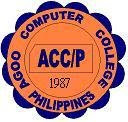UNIT TITLE : PERFORM COMPUTER OPERATIONS
UNIT CODE : 506311203
UNIT DESCRIPTOR : This unit covers the knowledge, skills, attitudes and values needed to perform computer operations which include inputting, accessing, producing and transferring data using the appropriate hardware and software.
ELEMENTS PERFORMANCE CRITERIA
Italicized terms are elaborated in the Range of Variables
1. Plan and prepare for task to be taken undertaken 1.1. Requirements of task are determined in accordance with the required output.
1.2. Appropriate hardware and software are selected according to task assigned and required outcome.
1.3. Task is planned to ensure that OH & S guidelines and procedures are followed.
1.4. Client -specific guidelines and procedures are followed.
1.5. Required data security guidelines are applied in accordance with existing procedures.
2. Input data into computer 2.1. Data are entered into the computer using appropriate program/application in accordance with company procedures.
2.2. Accuracy of information is checked and information is saved in accordance with standard operating procedures.
2.3. Inputted data is stored in storage media according to requirements.
2.4. Work is performed within ergonomic guidelines.
3. Access information using computer 3.1. Correct program/application is selected based on job requirements.
3.2. Program/application containing the information required is accessed according to company procedures.
3.3. Desktop icons are correctly selected, opened and closed for navigation purposes.
3.4. Keyboard techniques are carried out in line with OH & S requirements for safe use of keyboards.
4. Produce output/ data using computer system 4.1. Entered data are processed using appropriate software commands.
4.2. Data are printed out as required using computer hardware /peripheral devices in accordance with standard operating procedures.
4.3. Files and data are transferred between compatible systems using computer software, hardware/peripheral devices in accordance with standard operating procedures.
5. Use basic functions of a www-browser to locate information 5.1. Information requirements for internet search are established.
5.2. Browser is launched.
5.3. Search engine is loaded.
5.4. Appropriate search criteria/or URL of site is entered.
5.5. Relevant links are followed to locate required information.
5.6. Useful pages are bookmarked or printed as required.
6. Maintain computer equipment and systems 6.1. Procedures for ensuring security of data, including regular back-ups and virus checks are implemented in accordance with standard operating procedures.
6.2. Basic file maintenance procedures are implemented in line with the standards operating procedures.
RANGE OF VARIABLES
VARIABLE RANGE
1 Hardware and peripheral devices 1.1 Personal computers
1.2 Networked systems
1.3 Communication equipment
1.4 Printers
1.5 Scanners
1.6 Keyboard
1.7 Mouse
1.8 Voice/Data logger
2 Software Software includes the following but not limited to:
2.1 Word processing packages
2.2 Database packages
2.3 Internet
2.4 Spreadsheets
2.5 Client Specific Software
3 OH & S guidelines 3.1 OHS guidelines
3.2 Enterprise procedures
4 Storage media Storage media include the following but not limited to:
4.1 Diskettes
4.2 CDs
4.3 Zip disks
4.4 hard disk drives, local and remote
4.5 Optical drives
5 Ergonomic guidelines 5.1 Types of equipment used
5.2 Appropriate furniture
5.3 Seating posture
5.4 Lifting posture
5.5 Visual display unit screen brightness
6 Desktop icons 6.1 Icons include the following but not limited to:
6.2 Directories/folders
6.3 Files
6.4 Network devices
6.5 Recycle bin
6.6 Program icons
7 Maintenance 7.1 Creating and managing more space in the hard disk and other peripherals
7.2 Reviewing programs
7.3 Deleting unwanted files
7.4 Backing up files
7.5 Checking hard drive for errors
7.6 Using up to date anti-virus programs
7.7 Cleaning dust from internal and external surfaces
EVIDENCE GUIDE
1 Critical aspects of competency Assessment must show that the candidate:
1.1 Selected and used hardware components correctly and according to the task requirement
1.2 used basic software applications to create new files and documents
1.3 Produced accurate and complete data in accordance with the requirements
1.4 Used appropriate devices and procedures to transfer files/data accurately
1.5 Used basic functions of a www-browser to locate information.
2 Underpinning knowledge 2.1 Basic ergonomics of keyboard and computer user
2.2 Main types of computers and basic features of different operating systems
2.3 Main parts of a computer
2.4 Storage devices and basic categories of memory
2.5 Relevant types of software
2.6 General security, privacy legislation and copyright
2.7 Viruses
2.8 OH & S principles and responsibilities
2.9 Calculating computer capacity
2.10 Productivity Application
2.11 Business Application
2.12 System Software
3 Underpinning skills 3.1 Reading and comprehension skills required to interpret work instruction and to interpret basic user manuals.
3.2 Communication skills to identify lines of communication, request advice, follow instructions and receive feedback.
3.3 Technology skills to use equipment safely including keyboard skills.
4 Method of assessment The assessor may select two of the following assessment methods to objectively assess the candidate:
4.1 Direct Observation and Oral Questioning
4.2 Practical demonstration
5 Resource implication 5.1 Computer hardware with peripherals
5.2 Appropriate software
6 Context of Assessment Assessment may be conducted in the workplace or in a simulated environment
Wednesday, June 17, 2009
Subscribe to:
Posts (Atom)
